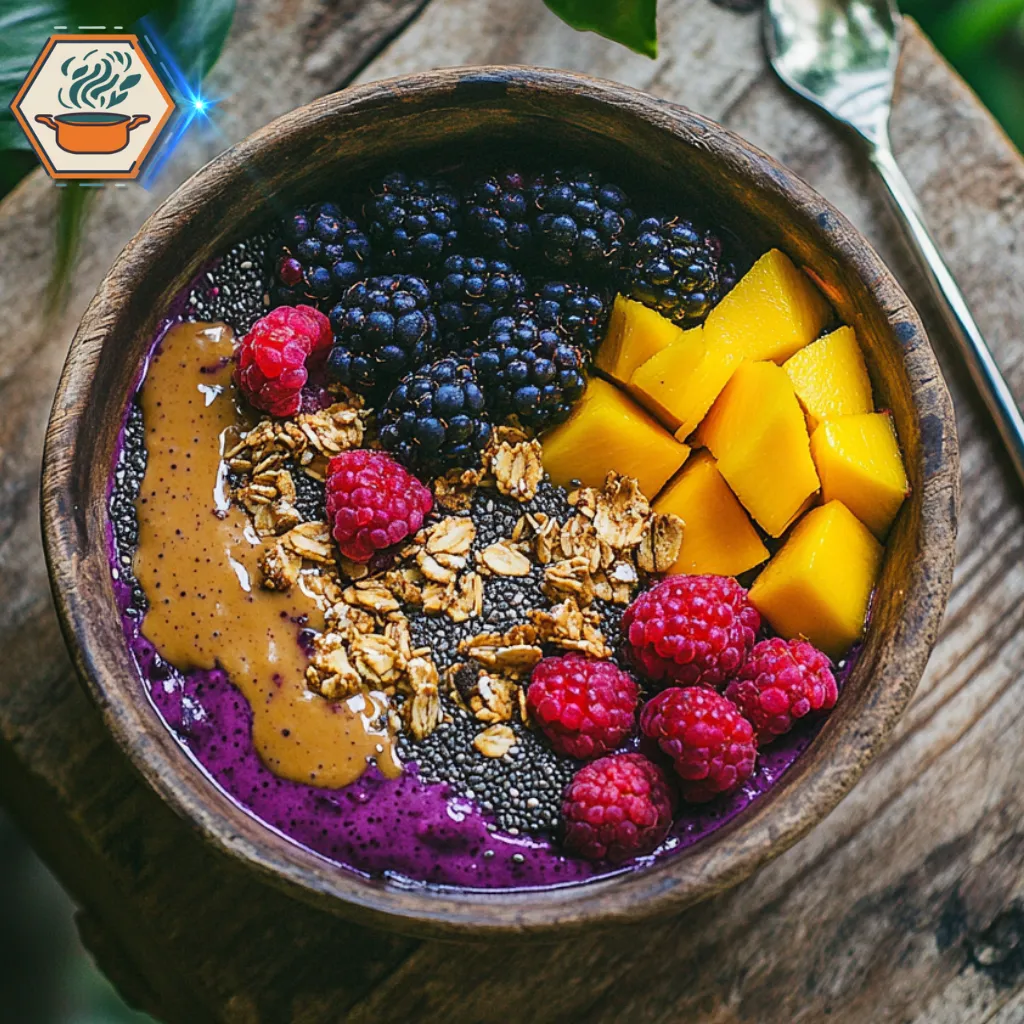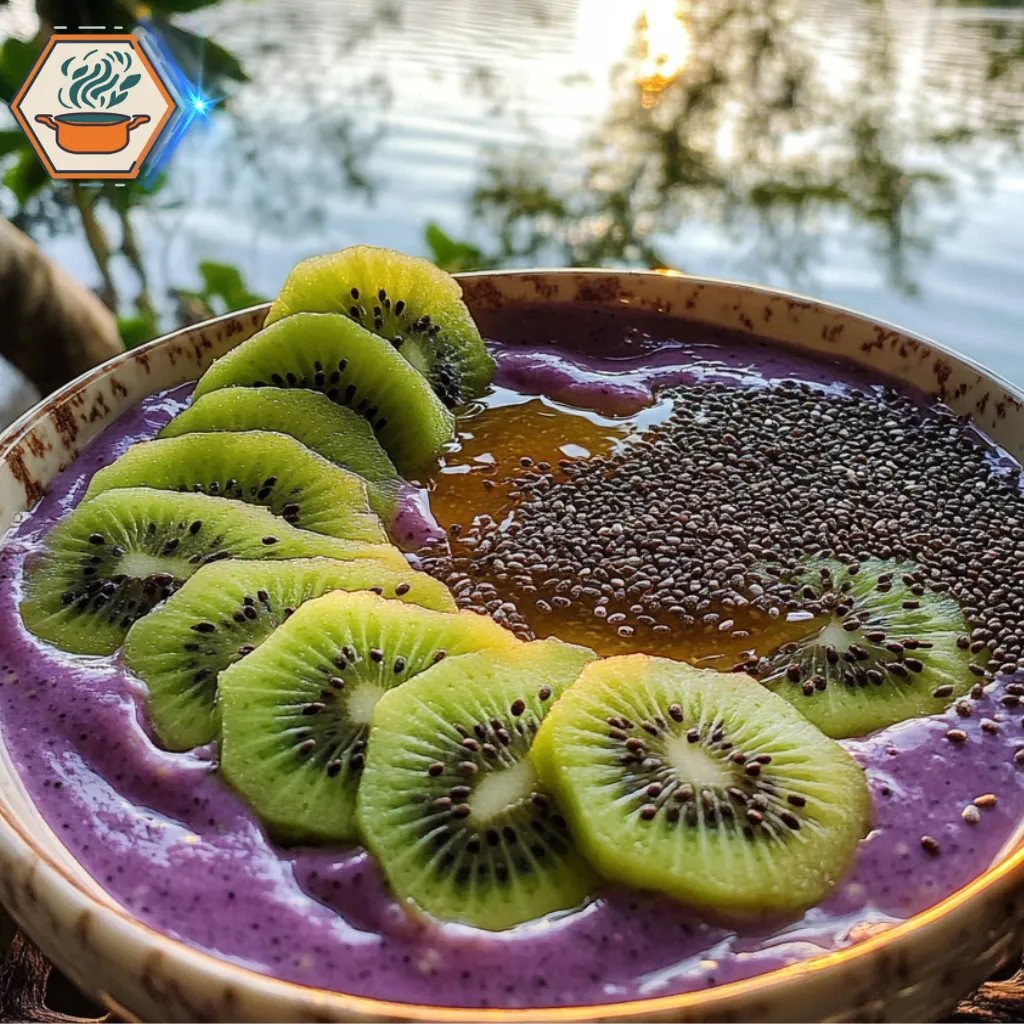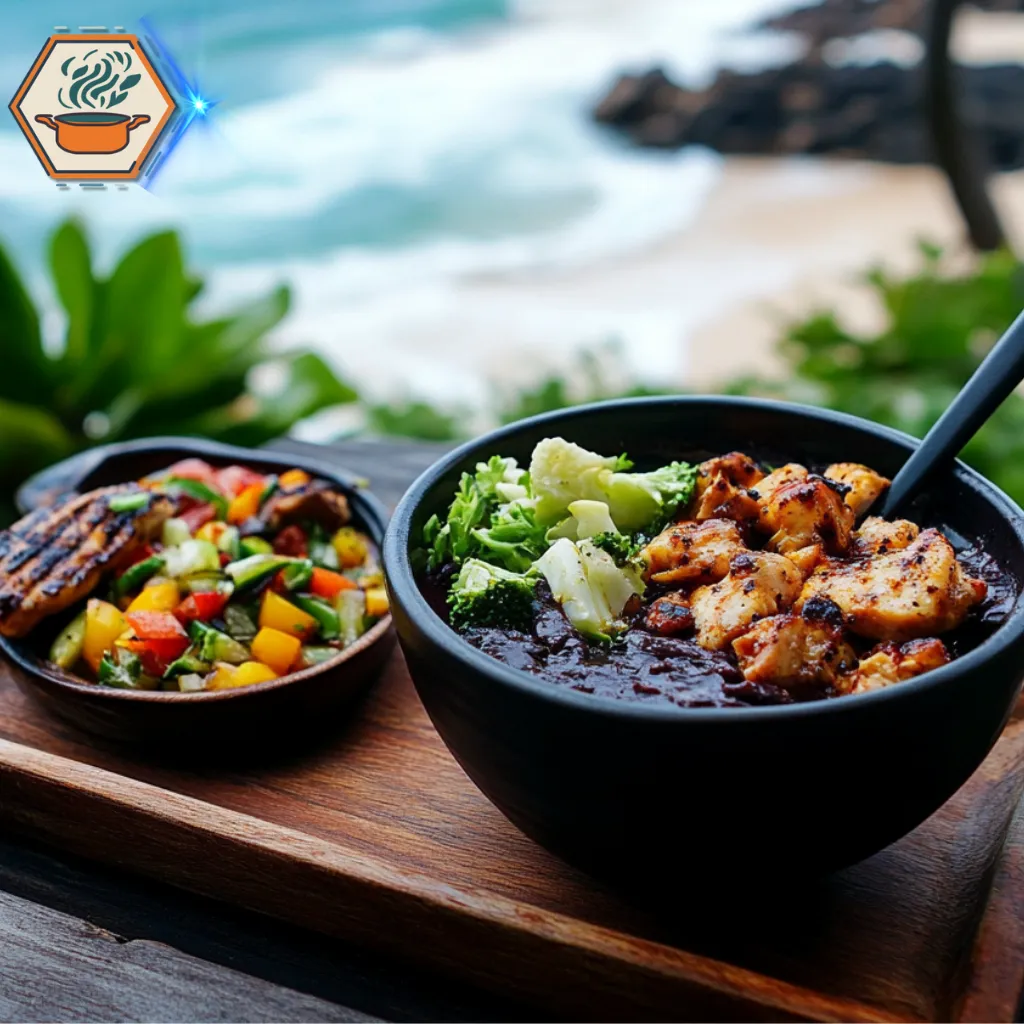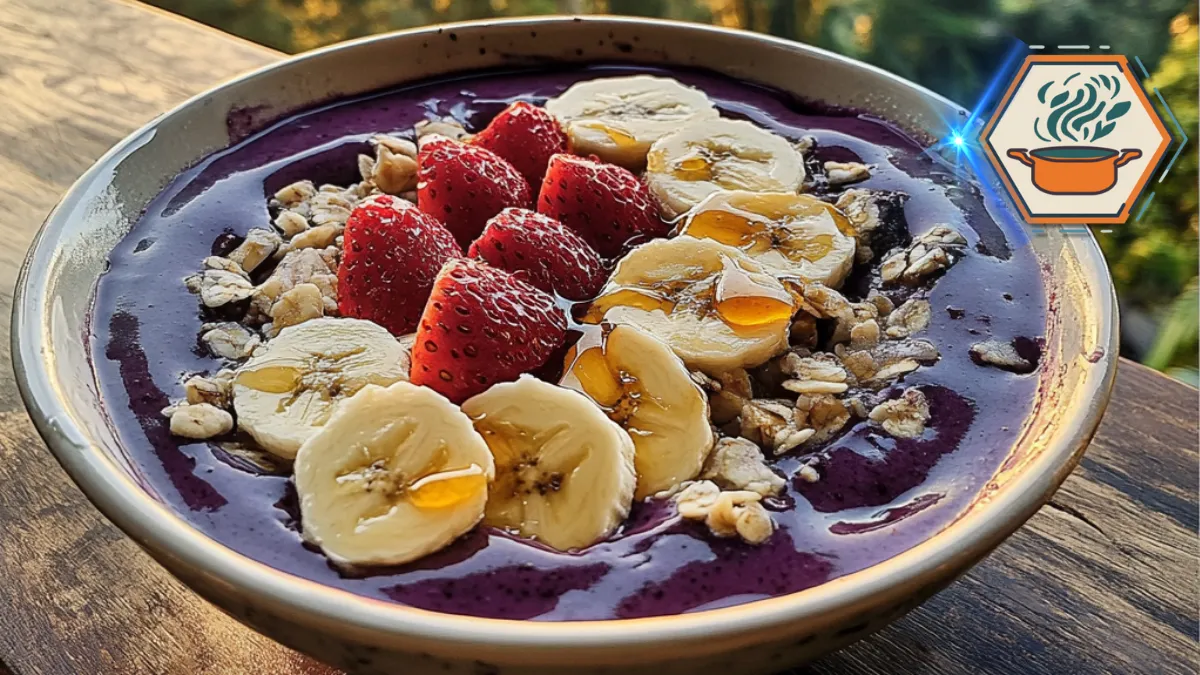Table of Contents
What Are Acai Bowls?
Acai bowls have become a popular choice for breakfast and snacks worldwide, but many people often ask, are acai bowls healthy enough for regular consumption?. But are acai bowls healthy? These colorful bowls feature a base made from acai berries, a superfood packed with nutrients. Topped with fruits, nuts, and granola, they are visually appealing and nutrient-rich. However, understanding their origins, ingredients, and nutrition is key to deciding if they suit your diet.
Overview of Acai Bowls
Are acai bowls healthy for daily meals? Acai bowls are smoothie-like dishes served in a bowl and eaten with a spoon. The main ingredient is acai berry puree. Acai berries are small, dark purple fruits from the Amazon rainforest. When blended, they create a thick, creamy texture, perfect for layering with toppings. Acai bowls are often praised for their antioxidant content and refreshing taste.
These bowls are versatile, offering endless topping combinations. You might find bananas, strawberries, or blueberries alongside crunchy granola or seeds. Many enjoy them as a light meal or snack.
Acai bowls have become increasingly popular due to their reputation for offering various health benefits. But like any food, their healthiness depends on how they are made and consumed.
Origins and Cultural Significance
The acai berry has been a staple food for indigenous Amazonian communities for centuries. Traditionally, it was mashed into a paste and paired with fish or cassava. The berry was valued for its energy-boosting properties and nutrients.
In the 1990s, acai made its way to global markets, starting in Brazil. It became popular as a frozen puree in cafes, beach kiosks, and juice bars. Today, acai bowls are a global phenomenon, especially in health-conscious communities.
Despite its modern popularity, acai retains cultural significance in its native regions. It remains a vital food source and symbol of Amazonian heritage.
Common Ingredients and Variations

While the base of an acai bowl is typically frozen acai puree, recipes often include other ingredients for flavor and texture.
Base Ingredients
- Frozen acai puree: The foundation of the dish.
- Bananas: Add sweetness and creaminess.
- Berries: Strawberries or blueberries enhance flavor and nutrition.
- Non-dairy milk: Almond, coconut, or oat milk is often used for blending.
Popular Toppings
- Fresh fruit: Mangoes, kiwis, or pineapple for sweetness.
- Granola: Adds crunch and fiber.
- Seeds: Chia or flax seeds provide omega-3s.
- Nut butter: Almond or peanut butter adds protein.
- Coconut flakes: For texture and tropical flavor.
Some variations include additional ingredients like protein powder or cacao nibs. These customize the bowl to suit dietary needs.
However, many store-bought acai bowls contain added sugar or syrups. Homemade versions can help control these extra ingredients. Check out our guide on how to make puree for tips on creating your own acai base.
Nutritional Profile of Acai
Are acai bowls healthy because of their superfood status? Acai berries are often called a superfood due to their impressive nutrient profile, rich in antioxidants and healthy fats.
“Are acai bowls healthy because of their antioxidants? Acai bowls are renowned for their high antioxidant content, which plays a significant role in maintaining overall health.”
Key Nutrients in Acai
- Antioxidants: Help fight free radicals and reduce inflammation.
- Fiber: Supports digestion and gut health.
- Healthy fats: Contains omega-9 fatty acids, which benefit heart health.
- Vitamins: Rich in vitamin A and vitamin C.
However, the final nutrition of an acai bowl depends on its ingredients. A simple bowl with fresh fruits and seeds can be nutrient-dense and balanced. But toppings like sweetened granola, honey, or chocolate chips can increase sugar content.
For more insights into the health implications of added sugars, consider exploring Harvard Health’s article on The sweet danger of sugar. This resource provides detailed information on how reducing added sugar intake can support long-term health.
Health Benefits of Acai Bowls
Rich in Antioxidants
Are acai bowls healthy? One reason they are considered healthy is their high antioxidant content, which plays a significant role in maintaining overall health. Acai berries contain anthocyanins, powerful compounds that combat oxidative stress in the body. Oxidative stress can damage cells and lead to chronic diseases, including heart disease and certain types of cancer. Including antioxidants in your diet helps neutralize free radicals, protecting your cells and reducing inflammation.
ncorporating antioxidant-rich fruits into your diet can support skin health by combating oxidative stress and reducing inflammation. Fruits such as berries, cherries, and pomegranates are particularly high in antioxidants and have been associated with various health benefits.Harvard Health
Source of Essential Vitamins and Minerals

Acai bowls are packed with essential nutrients, making them a nutrient-dense addition to your meals. Key vitamins found in acai bowls include:
- Vitamin A: Supports vision, immunity, and skin health.
- Vitamin C strengthens the immune system and supports collagen synthesis for healthy skin and tissues.
- Vitamin E: Acts as an antioxidant and supports cell health.
Additionally, acai bowls contain important minerals like potassium, magnesium, and calcium, which contribute to muscle function, bone health, and heart rhythm regulation. The combination of these vitamins and minerals ensures that acai bowls provide a wide range of health benefits for your body.
For those seeking plant-based sources of vitamins and minerals, check out this article on vegan chorizo ingredients.
Impact on Digestion and Gut Health
Are acai bowls healthy for digestion? Acai bowls are a fantastic option for improving digestive health due to their fiber-rich ingredients like chia seeds and granola
The acai berry itself contains dietary fiber that can help regulate blood sugar levels and enhance feelings of fullness. This makes acai bowls a popular choice for those aiming to manage their weight or avoid unhealthy snacking.
To ensure your bowl remains healthy, choose unsweetened acai puree and limit sugary toppings. This small adjustment helps maintain stable blood sugar levels and avoids unnecessary calorie spikes.
Supporting Cardiovascular Health
Many people ask, are acai bowls healthy for heart health? Are acai bowls healthy for your heart? Acai bowls can significantly contribute to heart health due to their antioxidant content and healthy fats.Acai bowls are often considered healthy and delicious, but many wonder if they are healthy enough to enjoy frequently The anthocyanins in acai berries have been shown to improve cholesterol levels by reducing LDL (“bad”) cholesterol and increasing HDL (“good”) cholesterol. Better cholesterol levels reduce the risk of developing cardiovascular diseases.
Moreover, acai contains plant sterols, natural compounds that help maintain healthy blood vessels and improve circulation. These benefits make acai bowls an excellent dietary choice for promoting a healthy heart.
Potential Downsides of Acai Bowls
Acai bowls are often considered healthy and delicious, but many wonder, are acai bowls healthy enough to enjoy frequently? Understanding these potential downsides can help you enjoy them while maintaining a balanced diet.Sugar Content in Toppings
Are acai bowls healthy if they contain sugary toppings? While acai bowls are celebrated for their nutrient-rich base, the toppings you choose can significantly impact their overall healthiness. Many acai bowls are topped with ingredients like honey, granola, and fruits, which can dramatically increase their sugar content and calorie load. Being mindful of these additions is crucial when evaluating the health benefits of your acai bowl.
Granola
Granola is a popular topping for acai bowls because of its crunchy texture and added fiber. However, are acai bowls healthy when topped with store-bought granola? Not always. Many commercial granolas are loaded with added sugars, oils, and preservatives. A single serving may contribute significantly to daily sugar intake, potentially leading to energy spikes and crashes.
Healthier Alternative: Opt for homemade or low-sugar granola varieties. Look for options with natural sweeteners like honey in moderation or no added sugar at all. You can also use plain rolled oats with seeds for added crunch without the sugar overload.
Honey and Syrups
Sweeteners like honey, agave nectar, and maple syrup are often drizzled over acai bowls for extra flavor. But are acai bowls healthy when these sugary syrups are used excessively? Although these sweeteners are more natural than refined sugar, they are still concentrated sources of sugar and can quickly elevate the calorie content.
Healthier Alternative: Use sweeteners sparingly or replace them with naturally sweet ingredients like sliced berries or a light dusting of cinnamon for flavor without added sugar.
Fruits
Fresh fruits are nutrient-dense and packed with vitamins, but are acai bowls healthy when they include high-sugar fruits? While fruits like bananas, mangoes, and pineapples provide natural sweetness, they also contain higher amounts of sugar compared to berries. Overloading your bowl with these fruits can tip the balance from healthy to sugar-heavy.
Healthier Alternative: Choose low-sugar fruits such as berries (blueberries, raspberries, strawberries) or kiwi. These options provide antioxidants and fiber without excessive sugar.
Excess sugar consumption can lead to weight gain, energy spikes, and dental issues. To minimize sugar, consider toppings like nuts, seeds, or unsweetened coconut. For more tips on creating balanced meals, check out our guide to perfect meatloaf every time.
Caloric Considerations
Are acai bowls healthy for weight management? Are acai bowls healthy for weight loss? While acai bowls are nutrient-rich, they can also be high in calories, depending on their size and toppings. A standard bowl can easily contain 500–700 calories or more, especially if made with:
- Blended Bases: Some recipes use juices or sweetened yogurt as a base, increasing calorie counts.
- Generous Toppings: Layering granola, nut butters, and dried fruits can add hundreds of calories.
| Ingredient | Serving Size | Calories | Sugar (g) | Notes |
|---|---|---|---|---|
| Acai Puree | 100g | 70 | 0 | Low-calorie and naturally unsweetened. |
| Granola | 1/4 cup | 120 | 5-8 | Choose low-sugar or homemade options. |
| Honey | 1 tablespoon | 64 | 17 | Use sparingly to reduce added sugars. |
| Banana | 1 medium | 105 | 14 | High in natural sugar but nutrient-dense. |
| Peanut Butter | 1 tablespoon | 90 | 1 | High-calorie; opt for natural, unsweetened. |
| Coconut Flakes | 2 tablespoons | 70 | 1 | Adds flavor with minimal sugar impact. |
If you’re aiming to manage weight, portion control is key. Opt for smaller bowls or limit calorie-dense ingredients. Pairing an acai bowl with a lower-calorie meal later in the day helps maintain balance.
Allergies and Dietary Restrictions
For individuals with specific dietary needs, answering are acai bowls healthy depends largely on carefully selecting ingredients that align with their health requirements. While acai bowls can be a nutritious choice, the toppings and add-ins can present risks for people with certain allergies or intolerances. Understanding these factors is key to determining are acai bowls healthy for everyone.
Nut Allergies: A Common Concern
Are acai bowls healthy for people with nut allergies? Many popular toppings like almond butter, peanut butter, and walnuts can be dangerous for individuals with nut allergies. Cross-contamination in pre-made bowls at restaurants can also pose hidden risks.
Healthier Alternative:
To keep acai bowls healthy for nut-allergic individuals, opt for seed-based toppings like sunflower butter, chia seeds, or pumpkin seeds. These alternatives provide similar texture and nutrition without the allergy risk, ensuring acai bowls are healthy and safe to eat.
Gluten Sensitivity: Hidden Gluten in Toppings
For those with gluten sensitivity or celiac disease, the question are acai bowls healthy depends on the choice of gluten-free ingredients. Granola is a popular topping, but many store-bought versions contain gluten unless specifically labeled gluten-free.
How to Stay Healthy:
Choose certified gluten-free granola or make your own with oats, seeds, and nuts to ensure that acai bowls are healthy and safe for gluten-sensitive individuals.
Dairy Intolerance: Choosing the Right Base
Dairy-based ingredients like yogurt or milk are sometimes used to blend acai bowls, raising concerns for those with lactose intolerance. So, are acai bowls healthy for those avoiding dairy?
Better Options:
To make sure acai bowls are healthy for lactose-intolerant or dairy-free diets, use non-dairy milk alternatives such as almond milk, coconut milk, or oat milk. Plant-based yogurts can also be a great substitute, keeping acai bowls healthy and inclusive.
Balancing Acai Bowls with Other Meals

Are acai bowls healthy as a daily meal? While acai bowls provide antioxidants, vitamins, and fiber, relying solely on them can create nutritional gaps in your diet.
To ensure a well-rounded diet:
- Add Protein: Consider including a scoop of protein powder or topping with chia seeds.
- Include Healthy Fats: Avocado, flaxseeds, or a drizzle of almond butter can enhance nutritional value.
- Complement Other Meals: Pairing an acai bowl with high-protein meals like chicken salads or soups later in the day can help.
Balancing your meals ensures you get all the nutrients your body needs, preventing over-reliance on acai bowls for sustenance.
Tips to Make Acai Bowls Healthier
When considering are acai bowls healthy, it’s important to understand how to make them more nutritious without compromising their delicious taste. By choosing the right ingredients and practicing portion control, you can enjoy a guilt-free treat packed with essential nutrients. Below are some practical tips to improve the healthiness of your acai bowl.
Sugar Content in Toppings
Are acai bowls healthy when loaded with sugary toppings? This is a critical question for anyone striving to maintain a nutritious diet. While acai bowls are often celebrated for their health benefits, their overall nutritional value can be compromised by certain high-sugar toppings. Understanding how these ingredients impact the healthiness of your bowl is essential when evaluating, are acai bowls healthy.
Granola: A Hidden Source of Sugar
Granola is a common topping, but are acai bowls healthy when packed with sugar-laden granola? Many store-bought granolas contain added sugars and unhealthy oils. Even a small serving can contribute significantly to your daily sugar intake, turning a nutrient-rich acai bowl into a high-calorie treat.
How to Keep Acai Bowls Healthy:
To ensure that acai bowls are healthy, opt for homemade or low-sugar granola. Choose granola made from oats, nuts, and seeds with minimal added sweeteners. This swap can significantly lower sugar content and help keep acai bowls healthy.
Honey and Syrups: Natural but Misleading
Many people drizzle honey, agave nectar, or maple syrup over their bowls, but are acai bowls healthy with these sweeteners? Although these are natural sugars, they are still concentrated sources of sugar that can raise blood sugar levels and calorie intake.
Healthier Choice:
If you’re asking yourself, are acai bowls healthy, the answer depends on moderation. Use these sweeteners sparingly or replace them with naturally sweet fruits like berries to keep acai bowls healthy and balanced.
Fruit Choices Matter
Fruits are essential for flavor and nutrition, but are acai bowls healthy when topped with high-sugar fruits? Fruits like bananas, mangoes, and pineapples are delicious but can significantly increase the sugar content of your bowl.
Better Alternatives:
For a more balanced option, focus on low-sugar fruits such as blueberries, raspberries, and kiwi. These fruits help ensure that acai bowls are healthy while still offering natural sweetness and essential nutrients.
Adding Low-Sugar Toppings
Toppings can elevate your acai bowl’s taste, but sugary additions like granola, sweetened coconut flakes, and chocolate chips can make them less healthy. Opt for low-sugar toppings to strike the perfect balance.
Low-Sugar Topping Ideas:
- Fresh fruits like berries, kiwi, or banana slices.
- Add a satisfying crunch with nuts like almonds, walnuts, or cashews.
- Seeds like chia, flax, or pumpkin for healthy fats and fiber.
- Unsweetened coconut flakes.
| Ingredient | Calories (per 1 tbsp) | Sugar (g) | Fiber (g) | Protein (g) |
|---|---|---|---|---|
| Fresh Blueberries | 5 | 0.1 | 0.2 | 0 |
| Sliced Banana | 14 | 2 | 0.2 | 0.1 |
| Almond Butter | 98 | 0.2 | 1.5 | 2.4 |
| Chia Seeds | 58 | 0 | 4 | 2 |
| Unsweetened Coconut Flakes | 33 | 0.1 | 0.3 | 0.3 |
Consider these alternatives to keep sugar levels in check while still making your bowl visually appealing and flavorful.
Incorporating Protein and Fiber
Adding protein and fiber to your acai bowl makes it more filling and helps regulate blood sugar levels. Both nutrients are essential for maintaining energy throughout the day.
High-Protein Additions:
- Greek yogurt or plant-based yogurt.
- Protein powder (whey or plant-based).
- Nut butters like almond butter or peanut butter.
Fiber-Rich Additions:
- Oats or quinoa flakes.
- Fresh fruits such as apples or pears.
- A tablespoon of ground flaxseeds or chia seeds.
Best Practices for Portion Control
Even healthy ingredients can lead to excess calorie consumption if not portioned correctly. Portion control is key to keeping your acai bowl a healthy choice.
Tips for Portioning:
- Stick to a serving size of acai puree (about 100 grams or a single packet).
- Use small bowls to avoid overfilling.
- Limit the number of toppings to three or four.
- Measure toppings like nuts, seeds, and granola to prevent overindulgence.
These strategies help you enjoy a nutritious bowl without unintended calorie overload.
For more tips on crafting nutritious meals, consider exploring Medical News Today’s article on 29 nutrition tips to improve health for everyone. This resource offers science-based advice to help you make healthier dietary choices.

